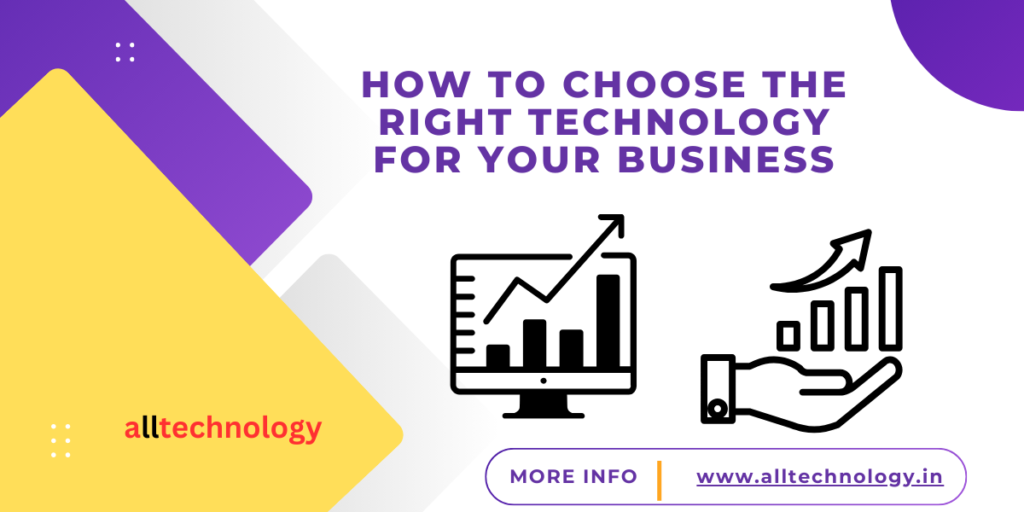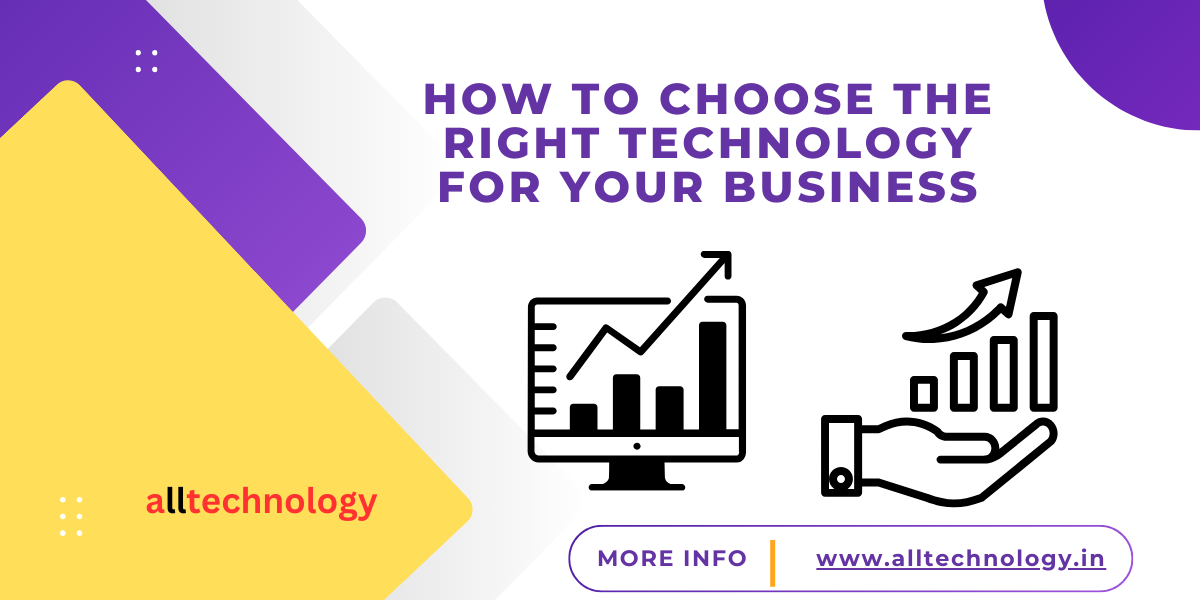Hello Bloggers welcome alltechnology blog. In this blog you will learn How to Choose the Right Technology for Your Business. In today’s fast-paced digital landscape, selecting the appropriate technology for your business is paramount. It’s not merely about keeping up with trends; it’s about making strategic decisions that drive growth and efficiency. As we delve into this intricate process, two crucial concepts—perplexity and burstiness—can offer valuable insights into creating a balanced and dynamic approach.

How to Choose the Right Technology for Your Business
Navigating the digital landscape to find the right technology for your business can feel like traversing a labyrinth. Each turn presents new options, each more enticing than the last. To emerge victorious, here are ten essential points to consider.
1. Assess Your Business Needs
Begin with introspection: what does your business truly require? Identify the core functions that technology must support. Are you looking to streamline operations, enhance customer engagement, or improve data analytics? Pinpointing these needs will guide your technology choices and prevent costly missteps.
2. Budget Constraints and Cost Analysis
Budgeting for new technology is akin to planning an expedition. You’ll need to account for upfront costs, ongoing maintenance, and potential upgrades. Remember, the most expensive option isn’t always the best. Perform a cost-benefit analysis to understand the long-term financial impact and ensure it aligns with your business goals.
3. Scalability and Future-Proofing
In the ever-evolving tech world, today’s cutting-edge solution might be obsolete tomorrow. Choose technology that can scale with your business growth. Future-proofing your investments means opting for flexible, upgradable solutions that adapt to changing demands without requiring a complete overhaul.
4. Integration with Existing Systems
New technology should be a seamless addition, not a disruptive force. Evaluate how well a prospective solution integrates with your current systems. Compatibility is crucial for maintaining workflow continuity and avoiding data silos. This step ensures smooth transitions and sustained productivity.
5. Vendor Reputation and Support
Selecting a technology vendor is not just about the product; it’s about the partnership. Research vendors thoroughly. Look into their reputation, customer service quality, and support offerings. A reliable vendor should provide robust support, regular updates, and a clear roadmap for future developments.
6. User Experience and Training
Even the most advanced technology is useless if your team can’t use it effectively. Prioritize user-friendly solutions and invest in comprehensive training programs. Consider the learning curve and ensure that the transition period doesn’t hinder day-to-day operations.
7. Security and Compliance
In an age where data breaches are a constant threat, security cannot be an afterthought. Evaluate the security features of any technology you consider. Ensure it complies with relevant regulations and industry standards to protect sensitive information and maintain customer trust.
8. Innovation and Competitive Advantage
Technology should be an enabler of innovation, giving your business a competitive edge. Look for solutions that not only solve current problems but also open doors to new opportunities. Stay ahead of industry trends and leverage technology to differentiate your offerings from competitors.
9. Customer Feedback and Peer Reviews
Sometimes, the best insights come from those who have walked the path before you. Seek out customer feedback and peer reviews of the technology you’re considering. Real-world experiences can reveal hidden pros and cons, helping you make a more informed decision.
10. Trial and Error
Finally, don’t be afraid to experiment. Pilot programs and trial periods can provide valuable hands-on experience with new technology. Use these opportunities to assess functionality, usability, and overall fit before committing to a full-scale implementation.
Understanding Your Needs
First and foremost, comprehensively assessing your business requirements is essential. This involves a deep dive into your operational workflows, pinpointing inefficiencies, and identifying areas ripe for technological intervention. Are you aiming to enhance customer service, streamline internal processes, or boost your online presence? Each goal demands a tailored technological solution.
Evaluating Options
Once you have a clear understanding of your needs, the next step is to explore the available technological options. The market is teeming with solutions, from enterprise software and cloud services to AI-driven analytics and IoT devices. However, not all technologies are created equal, and what works for one business may not be suitable for another. Here, the concepts of perplexity and burstiness come into play. Complex, multifaceted technologies might offer more advanced features but can be overwhelming if not properly managed. On the other hand, simpler solutions might lack the depth your business requires but are easier to implement and use.
Cost vs. Benefit Analysis
Financial considerations inevitably play a crucial role in decision-making. A detailed cost-benefit analysis can illuminate the long-term value of your investment. It’s not just about the initial outlay but also ongoing maintenance costs, potential downtime during implementation, and training expenses. Remember, the most expensive option isn’t always the best. Similarly, the cheapest solution may incur hidden costs that outweigh its upfront savings.
Scalability and Future-Proofing
Another pivotal factor is scalability. As your business grows, your technological needs will evolve. Investing in scalable solutions ensures that your technology can grow alongside your business, saving you from frequent, costly upgrades. Furthermore, consider future-proofing your technology. Will it adapt to emerging trends and innovations, or will it become obsolete in a few years? Forward-thinking technology choices can provide a competitive edge and long-term stability.
Security Considerations
In the digital age, cybersecurity cannot be an afterthought. Ensuring that your chosen technology has robust security measures is vital to protecting sensitive data and maintaining customer trust. Look for solutions that offer encryption, regular updates, and comprehensive support to safeguard against cyber threats.
User Experience and Training
Finally, the user experience is a critical aspect that can determine the success or failure of a technology implementation. No matter how advanced or feature-rich a solution is, if it’s not user-friendly, it will face resistance from your team. Invest in technologies that are intuitive and provide adequate training and support to ensure smooth adoption and maximum productivity.
Conclusion
Choosing the right technology for your business is a multifaceted challenge that requires careful consideration of various factors. By embracing the concepts of perplexity and burstiness, you can navigate this complexity with a nuanced approach, balancing advanced features with usability and future potential. Ultimately, the right technology should align with your business goals, enhance operational efficiency, and position you for sustained growth and success.
FAQ
Question 1. How do I choose the right technology?
- Consider Your Company’s Requirements.
- Pick A Scalable Solutions.
- Find Talented Skills.
- Get External Support.
- Analyze Costs.
Question 2. How do business select business technology?
You need to choose appropriate technology for each workplace task.


